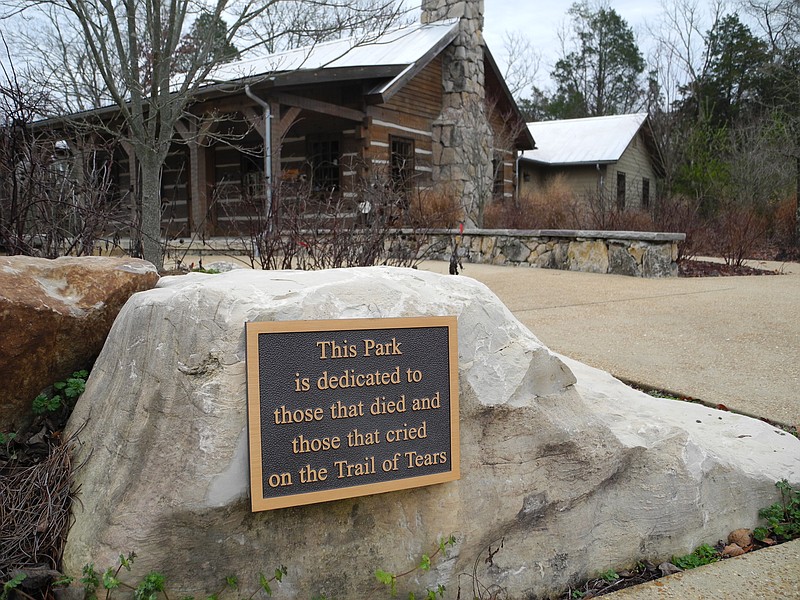Home to indigenous cultures for thousands of years, three of the seven sites in Tennessee that tell the story of Native Americans are in the Chattanooga area, according to the Tennessee Department of Tourism.
The state's name "Tennessee" is derived from "Tanasi," a Cherokee village in what is now Monroe County, officials said, noting the state today is home to more than 20,000 Native Americans. Travelers in Tennessee can find a rich experience of culture and history of Native American heritage, officials said Thursday in a news release.
One piece of Tennessee's Native American history that crosses many counties is the Trail of Tears National Historic Trail, which runs east to west across Tennessee and traces the tragic story of the removal of Cherokees from their ancestral homelands, officials said.
State tourism officials point to seven other sites in the state. Five of the seven sites -- including the Chattanooga area's three -- are in East Tennessee. The rest are in Middle Tennessee. Here are the seven sites:
Audubon Acres
Chattanooga's oldest wildlife sanctuary, Audubon Acres, offers more than 5 miles of hiking trails over 130 acres on South Chickamauga Creek, along with abundant opportunities for picnicking, wildlife viewing and photography. It's also a spot steeped in Native American history, and the visitor center houses an archaeological museum showcasing one of the largest publicly viewable Native American artifact collections in Chattanooga, while the Spring Frog Cabin, a Trail of Tears site, is a preserved example of Cherokee architecture from the mid-1700s. Going back even further, Little Owl Village at Audubon Acres is believed to be the site of a 16th century Napochie village that the Spanish Tristan DeLuna expedition encountered during its travels north from Florida, according to state officials.
Red Clay State Historic Park
The Trail of Tears begins at Red Clay State Historic Park in Bradley County. Encompassing 263-acres of narrow valleys formerly used as cotton and pastureland, the 41-year-old park site was the last seat of Cherokee national government before the Indian Removal Act, which resulted in most of the Cherokee people in the area being forced west in the 1830s. Here, the Cherokee learned they had lost their mountains, streams and valleys forever. Visitors will find hiking trails, reconstructed sleeping huts, homesteads, council houses, the Blue Hole Spring, which served as a water supply during council meetings, and the Eternal Flame, a memorial for the Cherokee people and those who were lost on the Trail of Tears, officials said.
(READ MORE: Cherokee Cultural Celebration set this weekend at Red Clay)
Cherokee Removal Memorial Park and Museum
The Cherokee Indian Removal Memorial Park and Museum on the banks of the Tennessee River in Meigs County's Birchwood community marks what was one of the main staging areas for the Trail of Tears. Thousands of Cherokees camped here before their infamous trip to the west. Lying near the center of the ancestral land of the Cherokee Nation, this area had nine encampments of thousands of Cherokees who waited weeks to be sent across the river at Blythe Ferry. Today, a History Wall feature offers visitors a detailed visual retelling of not only the Trail of Tears, but also the centuries-long saga of the literate and highly civilized Cherokee culture in Tennessee, officials said. A Memorial Wall, meanwhile, pays tribute to the people who died during the Trail of Tears -- a necessary reminder of that tragic episode in our nation's history.
The Sequoyah Birthplace Museum
With the Eastern Band of the Cherokee Nation at the helm, the Sequoyah Birthplace Museum is Tennessee's only tribally operated historical attraction. The East Tennessee museum tells the story of Sequoyah, creator of the Cherokee Syllabary writing system. Never before or since in the history of the world has one man, not literate in any language, perfected a system for reading and writing a language until Sequoyah. Located in the Great Smoky Mountains on the shores of Tellico Lake in Monroe County, the museum recently added the Max D. Ramsey Shoreline Trail, with 1.5 miles of walking trail, along the shoreline, bridges and boardwalks through the marshy areas.
Cumberland Gap National Historical Park
As the first great gateway to the American west, Cumberland National Historic Park in Claiborne County is a must for anyone learning about Tennessee's Native American history. Located an hour north of Knoxville where the borders of Tennessee, Kentucky and Virginia converge, the 24,000-acre park features miles of game trails originally used by Native Americans, allowing visitors to literally walk in the footsteps of the land's original stewards.
Pinson Mounds State Archaeological Park
Listed on the National Register of Historic Places, Pinson Mounds State Archaeological Park in Madison County covers more than 1,200 acres and contains at least 15 Native American mounds, which were both burial and ceremonial in purpose. The park's archaeological features and wildlife can be viewed along 6 miles of interconnecting trails, including paved trails, which are wheelchair and bicycle accessible, officials said.
(READ MORE: Support building to return Clingmans Dome to original Cherokee name)
The park's Pinson Mounds museum offers more insight into those structures; it is designed to replicate a Native American mound, offering 4,500 square feet of exhibit space, an archaeological library, an 80-seat theater and a discovery room for historical exploration.
Mound Bottom State Archaeological Area
Head to the 7-acre Mound Bottom State Archaeological Area in Kingston Springs (just west of Nashville) to see the largest number of Native American ceremonial mounds in Tennessee -- more than a dozen. Researchers believe the area was occupied between approximately 1000 and 1300 AD and was an important civic and ceremonial center connected to the Mississippian site of Cahokia, which was across the river in what is now St. Louis. The Mound Bottom site is only accessible to the public through hikes led by Harpeth River State Park rangers -- check the park's events calendar for upcoming experiences.
-- Compiled by Ben Benton

